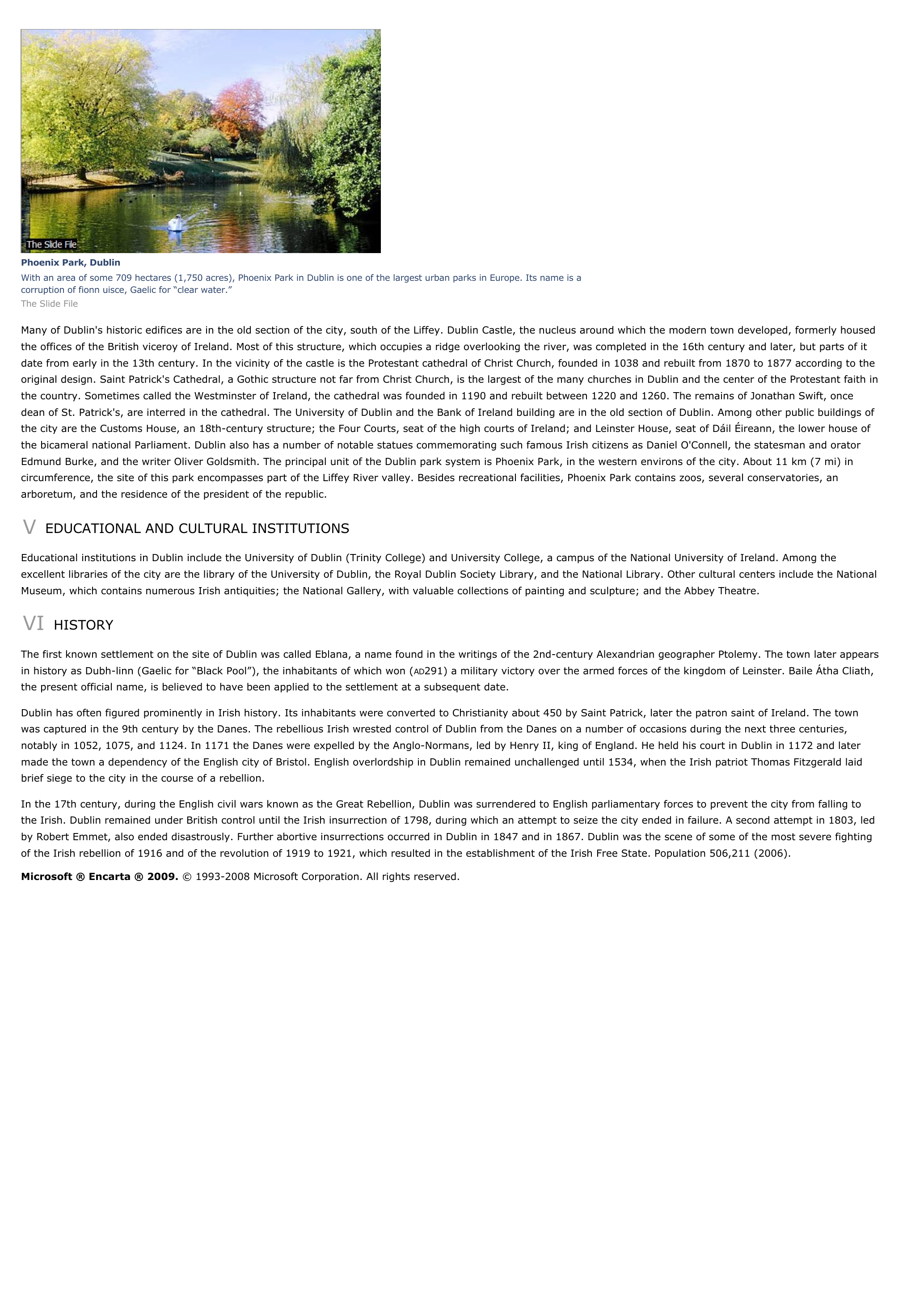Dublin (city, Ireland) - geography.
Publié le 27/05/2013

Extrait du document
«
Phoenix Park, DublinWith an area of some 709 hectares (1,750 acres), Phoenix Park in Dublin is one of the largest urban parks in Europe.
Its name is acorruption of fionn uisce, Gaelic for “clear water.”The Slide File
Many of Dublin's historic edifices are in the old section of the city, south of the Liffey.
Dublin Castle, the nucleus around which the modern town developed, formerly housedthe offices of the British viceroy of Ireland.
Most of this structure, which occupies a ridge overlooking the river, was completed in the 16th century and later, but parts of itdate from early in the 13th century.
In the vicinity of the castle is the Protestant cathedral of Christ Church, founded in 1038 and rebuilt from 1870 to 1877 according to theoriginal design.
Saint Patrick's Cathedral, a Gothic structure not far from Christ Church, is the largest of the many churches in Dublin and the center of the Protestant faith inthe country.
Sometimes called the Westminster of Ireland, the cathedral was founded in 1190 and rebuilt between 1220 and 1260.
The remains of Jonathan Swift, oncedean of St.
Patrick's, are interred in the cathedral.
The University of Dublin and the Bank of Ireland building are in the old section of Dublin.
Among other public buildings ofthe city are the Customs House, an 18th-century structure; the Four Courts, seat of the high courts of Ireland; and Leinster House, seat of Dáil Éireann, the lower house ofthe bicameral national Parliament.
Dublin also has a number of notable statues commemorating such famous Irish citizens as Daniel O'Connell, the statesman and oratorEdmund Burke, and the writer Oliver Goldsmith.
The principal unit of the Dublin park system is Phoenix Park, in the western environs of the city.
About 11 km (7 mi) incircumference, the site of this park encompasses part of the Liffey River valley.
Besides recreational facilities, Phoenix Park contains zoos, several conservatories, anarboretum, and the residence of the president of the republic.
V EDUCATIONAL AND CULTURAL INSTITUTIONS
Educational institutions in Dublin include the University of Dublin (Trinity College) and University College, a campus of the National University of Ireland.
Among theexcellent libraries of the city are the library of the University of Dublin, the Royal Dublin Society Library, and the National Library.
Other cultural centers include the NationalMuseum, which contains numerous Irish antiquities; the National Gallery, with valuable collections of painting and sculpture; and the Abbey Theatre.
VI HISTORY
The first known settlement on the site of Dublin was called Eblana, a name found in the writings of the 2nd-century Alexandrian geographer Ptolemy.
The town later appearsin history as Dubh-linn (Gaelic for “Black Pool”), the inhabitants of which won ( AD291) a military victory over the armed forces of the kingdom of Leinster.
Baile Átha Cliath, the present official name, is believed to have been applied to the settlement at a subsequent date.
Dublin has often figured prominently in Irish history.
Its inhabitants were converted to Christianity about 450 by Saint Patrick, later the patron saint of Ireland.
The townwas captured in the 9th century by the Danes.
The rebellious Irish wrested control of Dublin from the Danes on a number of occasions during the next three centuries,notably in 1052, 1075, and 1124.
In 1171 the Danes were expelled by the Anglo-Normans, led by Henry II, king of England.
He held his court in Dublin in 1172 and latermade the town a dependency of the English city of Bristol.
English overlordship in Dublin remained unchallenged until 1534, when the Irish patriot Thomas Fitzgerald laidbrief siege to the city in the course of a rebellion.
In the 17th century, during the English civil wars known as the Great Rebellion, Dublin was surrendered to English parliamentary forces to prevent the city from falling tothe Irish.
Dublin remained under British control until the Irish insurrection of 1798, during which an attempt to seize the city ended in failure.
A second attempt in 1803, ledby Robert Emmet, also ended disastrously.
Further abortive insurrections occurred in Dublin in 1847 and in 1867.
Dublin was the scene of some of the most severe fightingof the Irish rebellion of 1916 and of the revolution of 1919 to 1921, which resulted in the establishment of the Irish Free State.
Population 506,211 (2006).
Microsoft ® Encarta ® 2009. © 1993-2008 Microsoft Corporation.
All rights reserved..
»
↓↓↓ APERÇU DU DOCUMENT ↓↓↓
Liens utiles
- Dublin (city, Ireland) - geography.
- Buenos Aires (city) - geography.
- Mexico City - geography.
- Moscow (city, Russia) - geography.
- Paris (city, France) - geography.

































